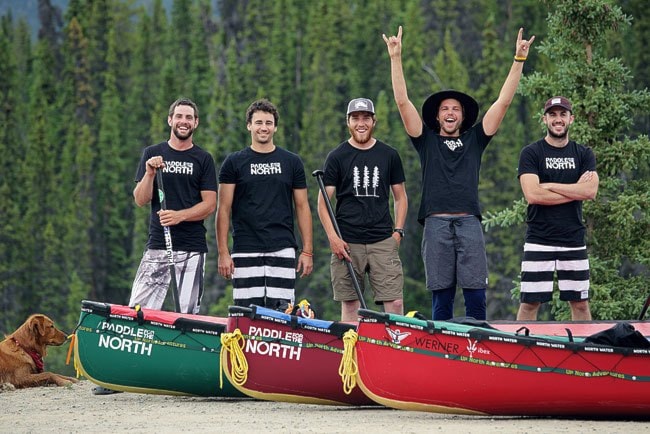When Gabe Rivest was a kid growing up in northern Quebec, his family used to dump limestone into the lake they lived on.
His parents would get together with their neighbours to buy the stuff. It was just something they did every year or two. To Rivest, at the time, it seemed normal. He didn’t realize they were doing it to protect fish and neutralize the effects of acid rain.
Experiences like that helped make him aware of how important and fragile the natural environment is, he said.
“Where I’m from, in northern Quebec, has been totally destroyed by mines, by logging, by all the big hydro dams.
“I saw it as a kid without really knowing what it was. We learn about the Amazon and the destruction there, but we don’t really learn about the forest in our own backyard,” Rivest said in an interview with the News in June.
Right now, he is somewhere north of Elliott Lake, paddling on the Hart River with five of his friends. It’s the trip of a lifetime, but they aren’t just out to experience the Peel watershed for themselves. They’re filming and photographing the entire two-month trip, and will produce a documentary film about the area.
The plan is to give Canadians and hopefully the world a stunning view of a currently pristine area that might not stay that way forever.
The expedition, called Paddle For The North, is the result of two years of planning, Rivest said.
“I always wanted to do some kind of documentary to raise awareness about issues in the North. That said, not necessarily being against any of the development.”
The Peel watershed is currently at the centre of a debate over land use planning in the territory. Proponents of development want to see the area opened up to potential mining and road access. Environmentalists want to see it safeguarded against that, and preserved.
Rivest said he and his six-person team aren’t setting out to argue one side or the other.
“It’s not about convincing them whether or not it’s good, it’s about letting them know what’s happening so they can make their own decisions,” he said.
“I met a Canadian mining engineer on a trip to Nicaragua, and was telling her about all the mining activity taking place in the Yukon. She said, ‘No, that’s not how it is in Canada.’ I find it really frustrating that people who are so well educated don’t even know what’s happening.”
Rivest acknowledged that the Peel is a high-profile issue right now, which will help the team get more attention and exposure, but he said he doesn’t want to limit his documentary to one flashpoint.
“For me, it was really important that this be about the North in general. That’s why we’re going to cross into the Yukon watershed, because it’s not on everyone’s radar so much right now.
“Our goal is not to stop all the mining, it’s to make sure that it’s managed in a more environmentally friendly way.
Rivest has made a splash with videos already. In November, Rivest and his friends published a two-minute clip of themselves playing hockey on Windy Arm while the lake was strikingly free of snow. The video soon went viral and has since been viewed more than 450,000 times.
To achieve his current, ambitious plans, Rivest recruited a team of five close friends. They have videographer/director Scott Sinton and web designer/ photographer Simon Lucas, both from New Zealand. Alexandre Deschenes is a geological engineer from Quebec. Professional river guide Matt Holmes and Dawson City gold miner Michah Rauguth round out the team.
“Scott’s goal is to make the first visually stunning canoe video,” Rivest said.
“A lot of canoe documentaries have been made, but they’re usually shot with small cameras, and the video quality isn’t great,” he said.
And they’re not just paddling into the wilderness with a few point-and-shoot cameras. They’re hauling a veritable studio worth of professional gear along with them. They have cameras, tripods, wireless microphones, batteries, and solar panels to recharge the whole kit.
“We’re geared up like you wouldn’t believe. We’ve got massive Pelican cases to fit in the boats,” Rivest said.
“That’s why we’re taking two months. The trip we’re doing could take a month and a half, but we wanted a little more time to do the rapids or take our time with portages if we have to.”
The trip will see them paddle the Hart, Peel, Rat, Porcupine, Yukon and Bell rivers. They’ll face rapids and a brutal eight-kilometre portage. They’ve arranged food drops in Fort McPherson and Old Crow, and will finish in Alaska before loading up and driving 22 hours home along the Dalton Highway.
Organizing the undertaking came easy for the group. Rivest has been guiding trips himself for six years in the Yukon. The hardest part, he said, was finding a way to finance it.
Each team member put up $2,000 each to help pay for the trip, and they’ve been fundraising all along. So far they’ve received almost $10,000 in donations, which can be made at paddleforthenorth.org while the team is on the trip. Supporters can also follow the team’s progress at Facebook.com/paddleforthenorth.
Once the trip is over, the team plans to take about a year to edit and produce the film. The final goal, Rivest said, is to present the finished product at outdoor film festivals and get it into schools.
The team has been on the water since July 3. Before they left, Rivest said he was starting to get a little nervous, but not as bad as his mom.
“My mom is a little worried. She decided to pay for the sat phone so we can call if something happens,” Rivest said.
Contact Jesse Winter at
jessew@yukon-news.com
